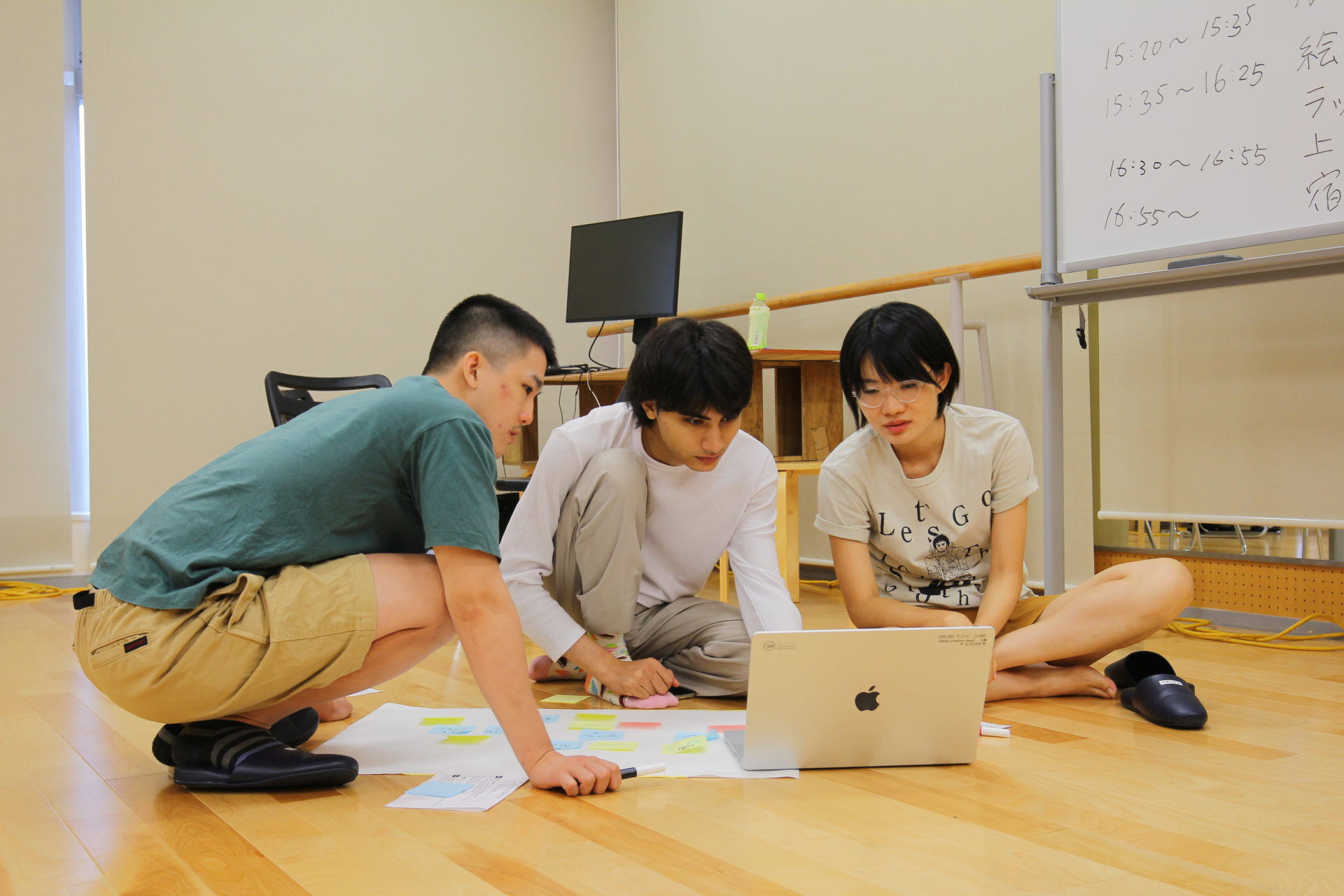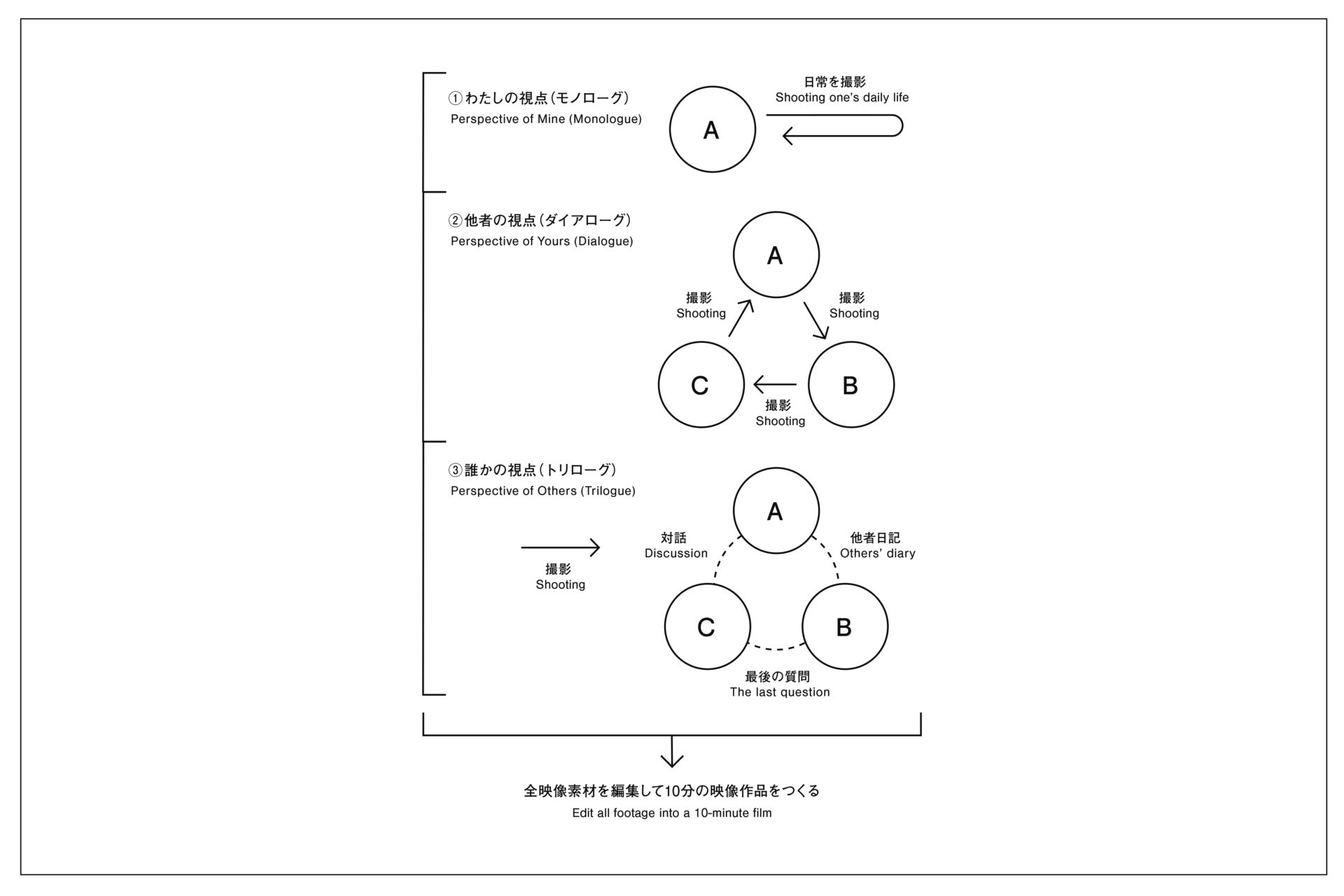
手法4:KINOローグMethod 4: KINO-Logue
KINOローグのルールThe rule of KINO-Logue
参加者たちは自身の日常を、「わたし」「他者」「誰か」の3つの視点から見つめ直し、その過程を経てグループで映像作品を制作する。
① わたしの視点で記録する(モノローグ|自身の日常を撮影する)
② 他者の視点で記録する(ダイアローグ|グループ内で互いの日常を撮影する)
③ 誰かの視点で記録する(トリローグ|グループで対話する様子を撮影する)
最後に行う③のセッションでは、①、②で撮影した映像素材をグループ内で共有した上でディスカッションを行い、その様子を撮影する。②で撮影した人の日常を“日記”として文章化した「他者日記」の朗読や、「最後の質問」として設定された「我々はどこから来たのか 我々は何者か 我々はどこへ行くのか」という問いかけなども取り入れながら、互いの日常の観察・撮影を通して発見したことを輪になって話し合う。
最終的に、①、②、③で撮影した全映像素材を組み合わせて、10分間の映像作品をグループごとに制作する。Participants will recapture their daily lives from three perspectives—“Mine”, “Yours”, and “Others”—and create a short video piece based on the group work process.
Session 1: Documenting Perspective of Mine (Monologue / Shooting one’s daily life)
Session 2: Documenting Perspective of Yours (Dialogue / Shooting group partner’s
daily life)
Session 3: Documenting Perspective of Others (Trilogue / Shooting the situation
of group discussion)
At session 3, participants share and discuss the video footage taken in session 1 and 2 within the group, and film their situation. As they gather in a circle, they recite “Other’s Diary”, a verbalization based on video footage of group partner’s daily life in session 2, question themselves with the “Final Question”, Where Do We Come From? What Are We? Where Are We Going?, and share what they have discovered through each other’s observation of daily lives and video shooting process. Each group eventually creates a 10-minute film combining all footage from session 1 to 3.

KINOローグの作品The works of KINO-Logue
「KINOローグ」は「シネマポートレイト」のワークショップを経験した人を対象とする“ステップアップワークショップ”のひとつである。シネマポートレイトが、指定されたエリアのなかで撮影・録音を実施するのに対し、KINOローグは、参加者それぞれの生活圏で実施する。撮影するのは、通い慣れた職場・学校への道のりや、頻繁に訪れる近所のスーパーマーケット、よく使う最寄りの駅といった本人にとっては見慣れたなんてことのない風景。それらの風景を、まずは自身で撮影し、次に同じグループに所属する別の参加者が撮影する。そうして、自身の日常の風景が他者の視点で切り取られ、自身もまた別の参加者の日常を切り取る。
撮影された映像には、それぞれの日常の圧倒的な差異が映る。どの映像も淡々とした日々の風景が連なるだけで、ドラマティックな展開が起こることはない。ただし、その風景にはそれぞれの人がいままでに行ってきた選択の積み重ねが映り、いまその人がそのような日常を送ることになった背景について意識を向けさせる。そして、その思考回路は自身の日常をも新鮮なものとして見せる。
それぞれの日常の差異からの気づきを、最後のディスカッションでは言葉として共有する。撮影した人の日常を言語化する「他者日記」は、断片的な映像の記録にささやかなストーリー性を加え、「最後の質問」として投げかけられる「我々はどこから来たのか 我々は何者か 我々はどこへ行くのか」という問いは、それぞれの日常を、自身の“ルーツ”に引き付けながら見つめなおすことを促す。そうした過程を経て生まれる「わたし」と「他者」の対話(logue)は、そのやりとりを見つめる鑑賞者である「誰か」に日常の風景に潜む複雑さを垣間見せる。“KINO-Logue” is one of the “step-up workshops” for participants who have experienced the “Cinema Portrait” workshop. While Cinema Portrait is a method to let participants take photos and record audio in a designated area, KINO-Logue takes place in each participant’s living area. For the participants, their subject is something simply familiar—the route to their workplace or school, the local supermarket, or the nearest train station. The participant first captures their living area by themselves, then have a group partner unfamiliar with the area do so. In this way, one’s daily life scenes are captured from another’s perspective, vice versa.
The resulting footage shows an overwhelming difference of how each captures their daily lives. Overall images are no more than a series of mundane day-to-day scenes without any dramatic developments. However, the scenery reflects the accumulation of choices that each person has made up until now, and makes us aware of the background context that led to that person leading their present life. This way of thinking even lets our own daily life seem fresh.
In the final discussion, participants will share their insights from the differences in their daily lives through words. “Other’s Diary”, a verbalization based on video of participant’s daily life, adds a modest narrative to the fragmentary footage, and the “Final Question”, Where Do We Come From? What Are We? Where Are We Going?, encourages participants to reconsider their daily lives while drawing back to their own “roots”. The dialogue between “me” and “you” that emerges through this process gives “others”, who perceive the interaction between the two, a glimpse of complexity hidden in quotidian scenery.

